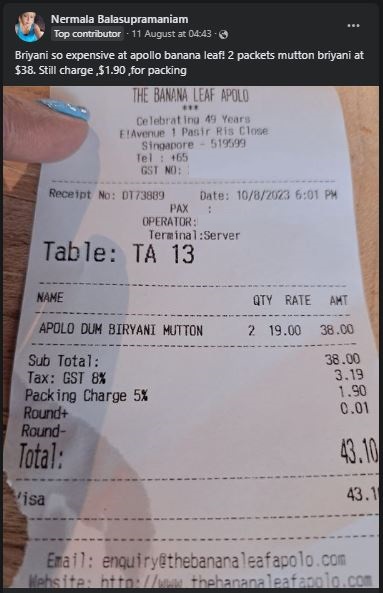In the realm of culinary surprises, prices that defy our expectations can occasionally take us aback. The recent news of a customer being charged a staggering S$19 for a packet of mutton biryani from The Banana Leaf Apolo at Downtown East has once again sparked a discussion about the costs associated with dining out.
Just as the shock of a S$12.50 plate of hokkien mee from Marina Bay Sands resonated with many, a similar sentiment has emerged around the hefty price tag attached to a packet of mutton biryani.
The customer in question, who shared her experience on social media, expressed her disbelief at the steep cost of the dish.
The receipt that accompanied the customer’s post outlined the breakdown of her bill. She was charged S$38 for two packets of mutton biryani.
Alongside the 8% Goods and Services Tax (GST) that is typically levied on restaurant bills, there was also a 5% packing charge. As a result, her total bill amounted to S$43.10.
The customer’s caption on her post echoed the sentiments of many who were taken aback by the pricing: “Briyani so expensive at apollo banana leaf! 2 packets [of] mutton briyani at $38. Still charge $1.90 for packing.”
Paying for brand or food
While such instances may seem isolated, they highlight broader issues surrounding restaurant pricing. The question arises: Are customers paying a premium for the name and reputation of a restaurant, or is there a genuine justification for these costs?
Restaurant pricing isn’t solely about recouping costs; it’s a delicate balance between factors like ingredient quality, location, rent, staff salaries, and desired profit margins. Restaurants often strive to strike the right equilibrium between offering value to customers and ensuring their own sustainability.
The inclusion of GST and service charges is a standard practice in the food industry. These additional charges contribute to the overall dining experience.
While they may cause initial sticker shock, they are a crucial part of the revenue stream that keeps restaurants operational.
The connection between price and customer satisfaction is intricate. While customers expect reasonable prices, they also associate higher prices with perceived quality. However, when the price exceeds their perceived value, it can lead to dissatisfaction and negative reviews.
Netizens’ comments
- By claiming inflation as a main cause, food sellers always exploited the situations by increasing prices here and there.
- Food sold are already considered as a package, why should we pay extra for packaging? That’s called extra profiteering!
- Honestly, prices at F&B seem to be going crazily high and not sure if the relevant authority is aware. Are we at the mercy of these F&B operators? Who is protecting the consumers’ interest?
- Should have said, mutton briyani take away, but don’t want the packaging. Came across some stall, take away 50cent so we bring our own container and still the stall says that cannot use the container reason,’ hygiene’.

